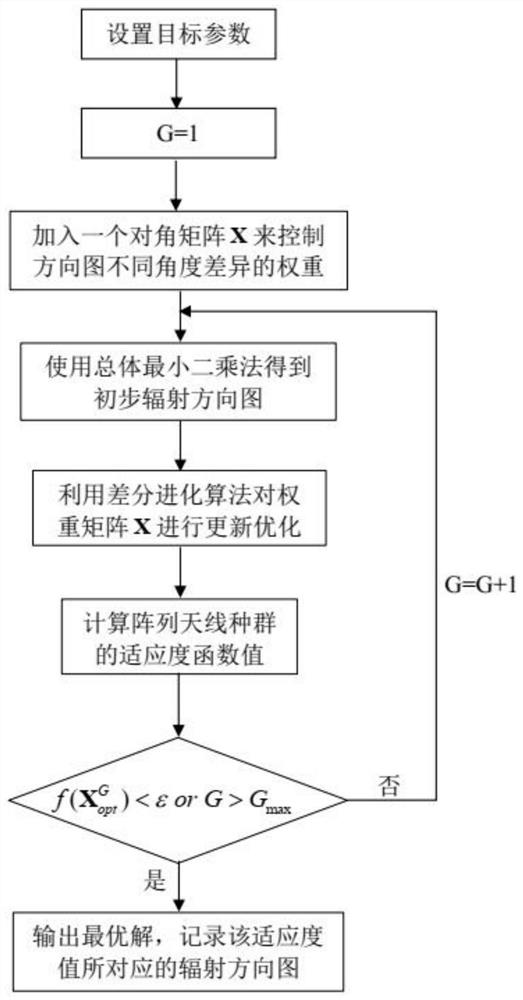Array pattern synthesis method based on hybrid differential evolution algorithm and weighted total least square method
A differential evolution algorithm and least squares technology, applied in the field of antennas, can solve the problems such as the inability to effectively control the side lobe level of the antenna array, the slow convergence speed of the bionic optimization algorithm, and the reduction of the side lobe level nulling depth. Sidelobe level, low zero, effect of increasing convergence speed
- Summary
- Abstract
- Description
- Claims
- Application Information
AI Technical Summary
Problems solved by technology
Method used
Image
Examples
Embodiment 1
[0072] Such as figure 1 As shown, an array pattern synthesis method based on hybrid differential evolution algorithm and weighted total least squares method includes the following steps:
[0073] Step 1: Set the target parameters of hybrid differential evolution algorithm and weighted total least squares method: population size, scaling factor, crossover probability, expected sidelobe level value and expected null trap depth value;
[0074] Step 2: The array pattern synthesis problem is written as the formula [A][I]=[S], and a diagonal matrix X is added to it to control the weight of the difference in different angles of the pattern, namely: [X][A][I ] = [S];
[0075] Step 3: Use the total least squares method to calculate the element current I in the array, and substitute it into the radiation pattern formula to obtain the preliminary radiation pattern;
[0076] Step 4: Use the differential evolution algorithm to update and optimize the weight matrix X;
[0077] Step 5: Ca...
Embodiment 2
[0081] Such as figure 1 As shown, an array pattern synthesis method based on hybrid differential evolution algorithm and weighted total least squares method includes the following steps:
[0082] Step 1: Set the target parameters of hybrid differential evolution algorithm and weighted total least squares method: population size, scaling factor, crossover probability, expected sidelobe level value and expected null trap depth value;
[0083] Step 2: The array pattern synthesis problem is written as the formula [A][I]=[S], and a diagonal matrix X is added to it to control the weight of the difference in different angles of the pattern, namely: [X][A][I ] = [S];
[0084] Further, in step 2, matrix A is the manifold matrix of the array:
[0085]
[0086] Among them, a ij is the element of the steering vector, it can be expressed by formula (2) as:
[0087]
[0088] k is the wave number of electromagnetic waves in free space, which can be expressed by formula (3):
[008...
PUM
| Property | Measurement | Unit |
|---|---|---|
| Height | aaaaa | aaaaa |
Abstract
Description
Claims
Application Information
 Login to View More
Login to View More - R&D
- Intellectual Property
- Life Sciences
- Materials
- Tech Scout
- Unparalleled Data Quality
- Higher Quality Content
- 60% Fewer Hallucinations
Browse by: Latest US Patents, China's latest patents, Technical Efficacy Thesaurus, Application Domain, Technology Topic, Popular Technical Reports.
© 2025 PatSnap. All rights reserved.Legal|Privacy policy|Modern Slavery Act Transparency Statement|Sitemap|About US| Contact US: help@patsnap.com



